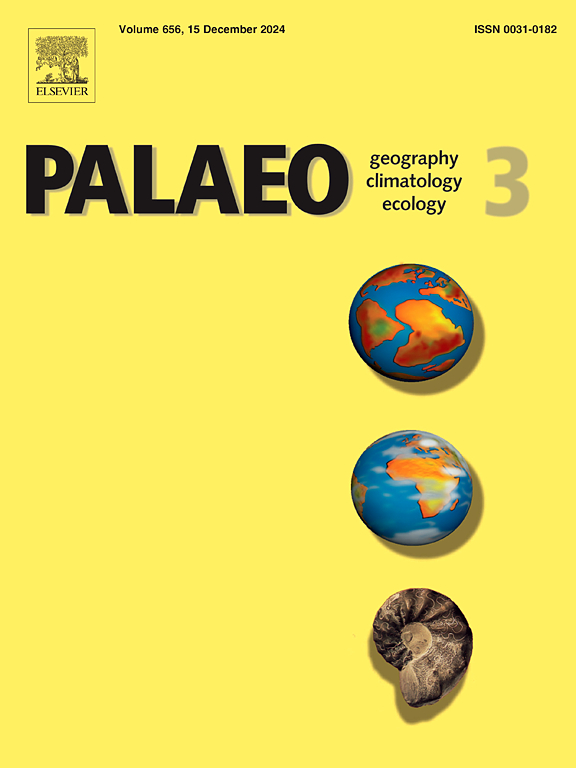海南岛与中国大陆之间琼州海峡的全新世演化:来自地质钻探的证据
IF 2.7
2区 地球科学
Q2 GEOGRAPHY, PHYSICAL
Palaeogeography, Palaeoclimatology, Palaeoecology
Pub Date : 2025-05-28
DOI:10.1016/j.palaeo.2025.113064
引用次数: 0
摘要
琼州海峡位于海南岛和中国大陆之间,经历了一个复杂的晚新生代演化过程,包括连续的海洋洪水和陆桥暴露阶段。它的最后一个全新世演化阶段对理解区域构造、气候动力学和古代人类迁移模式具有重要意义。在本文中,我们综合了钻井资料、微化石分析和AMS 14C测年,表明海峡两岸在~ 11.2 ka BP建立了海岸沉积,并在~ 9.0 ka BP发生了全面的东向西海水淹没。海峡的演化包括6个阶段:(1)约12.0 ka BP之前存在陆桥;(2)低洼地区海水淹没发生在~ 12.0 ~ 11.2 ka BP;(3)海平面快速上升和海峡完全开通发生在~ 11.2 ~ 9.0 ka BP;(4)海平面波动上升在约9.0-6.0 ka BP出现,在当前水平以上达到峰值2-3 m,并导致海峡最大宽度;(5)海平面回归和海洋平原暴露发生在~ 6.0 ~ 1.0 ka BP;(6)稳定海岸线在~ 1.0 ka BP后形成。这些阶段突出了冰期后海平面变化与区域构造沉降之间的相互作用,为重建南海北缘古环境变化提供了框架。在~ 9.0 ka BP,整个海洋连接的发展强调了海峡作为全新世水道走廊的长期重要性。本文章由计算机程序翻译,如有差异,请以英文原文为准。
Holocene evolution of the Qiongzhou Strait between Hainan Island and mainland China: Evidence from geological drilling
The Qiongzhou Strait, situated between Hainan Island and mainland China, has experienced a complex late Cenozoic evolution involving successive phases of marine flooding and land bridge exposure. Its last Holocene phase of evolution is important for understanding regional tectonics, climate dynamics, and ancient human migration patterns. In this paper, we integrate drilling data, microfossil analysis, and AMS 14C dating, to show that coastal sedimentation established on both sides of the strait at ∼11.2 ka BP, and full east-to-west seawater flooding occurred at ∼9.0 ka BP. The strait's evolution comprised six phases: (1) A land bridge existed before ∼12.0 ka BP; (2) Seawater inundation of low-lying areas occurred at ∼12.0–11.2 ka BP; (3) Rapid sea-level rise and complete strait opening occurred during ∼11.2–9.0 ka BP; (4) Fluctuating sea-level rise, peaking 2–3 m above current levels and resulting in maximum strait width, occurred at ∼9.0–6.0 ka BP; (5) Sea-level regression and marine plain exposure occurred ∼6.0–1.0 ka BP; (6) Stabilized coastlines developed after ∼1.0 ka BP. These stages highlight the interplay between postglacial sea-level changes and regional tectonic subsidence, providing a framework for reconstructing paleoenvironmental shifts in the northern margin of the South China Sea. The development of full marine connection at ∼9.0 ka BP underscores the long-term importance of the strait's role as a hydrographic corridor through the Holocene.
求助全文
通过发布文献求助,成功后即可免费获取论文全文。
去求助
来源期刊
CiteScore
5.90
自引率
10.00%
发文量
398
审稿时长
3.8 months
期刊介绍:
Palaeogeography, Palaeoclimatology, Palaeoecology is an international medium for the publication of high quality and multidisciplinary, original studies and comprehensive reviews in the field of palaeo-environmental geology. The journal aims at bringing together data with global implications from research in the many different disciplines involved in palaeo-environmental investigations.
By cutting across the boundaries of established sciences, it provides an interdisciplinary forum where issues of general interest can be discussed.

 求助内容:
求助内容: 应助结果提醒方式:
应助结果提醒方式:


